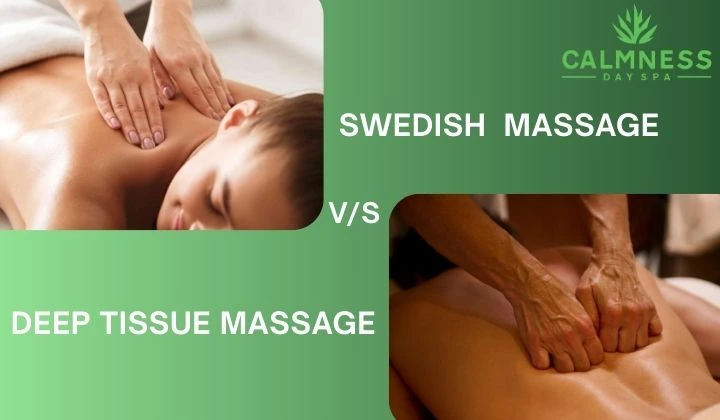Massage therapy is more than just a luxury; it’s a way to heal, relax, and restore balance. People often turn to it to ease stress, release tension, improve circulation, or manage chronic pain.
Among the many techniques available, Swedish massage and deep tissue massage are two of the most popular options. Both offer unique benefits, but they serve different purposes. Understanding how they work can help you decide which one is right for your body.
What Is Swedish Massage Therapy?

Swedish massage is often considered the classic form of massage therapy, originating in the early 19th century through the work of Swedish physiologist Per Henrik Ling. It’s designed to relax the entire body while also improving blood flow and easing muscle tension.
Techniques used: Therapists rely on long, flowing strokes, gentle kneading, circular movements, tapping, and light stretching. The pressure is usually light to medium, making it soothing and comfortable for most people.
Benefits: Swedish massage helps reduce stress, calm the nervous system, boost circulation, and promote overall relaxation. Many also report improved sleep quality and reduced anxiety after sessions.
Who it’s best for: If you’re new to massage, looking to unwind, or simply want a calming experience, Swedish massage is a perfect choice. It’s ideal for those seeking relaxation more than intense muscle work.
What Is Deep Tissue Massage Therapy?

Deep tissue massage goes beyond the surface, focusing on realigning deeper layers of muscles and connective tissue. It’s especially effective for chronic aches, stiffness, or injury recovery.
Techniques used: Therapists apply slow, firm pressure using their fingers, knuckles, elbows, or forearms. The strokes target knots, tight areas, and scar tissue buildup, working deep into the muscle layers.
Benefits: Deep tissue massage can ease chronic pain, improve mobility, reduce muscle tension, and support recovery from sports or repetitive strain injuries. It also helps release built-up toxins in the muscles, leaving you feeling lighter over time.
Who it’s best for: Athletes, people with desk-related posture issues, or anyone dealing with long-term muscle pain or stiffness will benefit most. However, it’s not always the most relaxing option, since the intensity can sometimes feel uncomfortable.
The History of Swedish and Deep Tissue Massage

Massage therapy takes us back to 3000 BC in India and China as a part of holistic healing, like Ayurvedic massage and Traditional Chinese Medicine. It spread worldwide, with Egyptians introducing reflexology and Greeks and Romans using it for athletes.
In the 19th century, Swedish massage was developed, and the 20th century brought modern styles like sports and deep tissue massage, forming today’s diverse practice.
Swedish Massage History
Swedish massage started in the early 1800s, thanks to Per Henrik Ling, a Swedish physiologist and gymnast.
He combined his knowledge of anatomy with movement techniques to create a system that improves circulation, eases tension, and boosts flexibility.
At first, it was mostly used for physical therapy and rehabilitation, but over time, it grew into a favorite for relaxation and overall wellness around the world.
Deep Tissue Massage History
Deep tissue massage has roots in both European and Asian therapeutic traditions. It developed as therapists focused on reaching deeper muscle layers and connective tissue to help with chronic pain, stiffness, and sports injuries.
By the 20th century, it became well-known as a therapeutic and recovery-focused massage, especially for athletes and people dealing with long-term muscle issues.
Key Differences Of Swedish and Deep Tissue Massage Therapy
Although both styles use touch and pressure to heal, their goals and techniques differ.
Here’s a breakdown:
Aspects | Swedish Massage | Deep Tissue Massage |
Pressure Intensity | Light to medium, gentle, and soothing | Firm to intense, target deeper muscle layers |
Purpose | Stress relief, relaxation, improved circulation | Pain relief, breaking down knots, and muscle recovery |
Duration & Recovery | Usually 60-90 minutes; minimal soreness after. | 60-90 minutes; may cause temporary soreness or stiffness |
Best For | Beginners, people seeking relaxation, and stress management | Athletes, chronic pain sufferers, and those with muscle tension or injuries. |
How to Choose the Right Massage for You?
Selecting the right massage depends on your goals, comfort, and lifestyle. Consider these factors:
- Your Health Goals: Relaxation and stress relief? Go for Swedish. Need pain relief or muscle recovery? Deep tissue is better.
- Pain Tolerance: Swedish is gentle and soothing, while deep tissue can feel intense or even slightly uncomfortable.
- Medical Conditions: Injuries, inflammation, or certain health issues require a professional’s guidance before a deep tissue session.
- Lifestyle: Office workers may benefit more from Swedish massage, whereas athletes or physically active people often need deep tissue to release tight muscles.
- Consult a Professional: When in doubt, talk to a licensed massage therapist. They can customize the pressure, techniques, and focus areas for your body.
Choose the Right Spa for Your Massage Experience
Choosing the right spa can make a huge difference in your massage experience. Look for licensed therapists, a clean and relaxing environment, and services that match your needs.
At Calmness Day Spa, we offer both Swedish and deep tissue massages tailored to your body’s goals. Whether you’re seeking relaxation, pain relief, or muscle recovery, our expert team can guide you to the perfect session.
Final Thoughts
Both Swedish and deep tissue massages offer unique benefits. Swedish massage helps you unwind, recharge, and reduce stress, while deep tissue targets chronic pain and muscle tension.
Listening to your body and understanding your goals is key; sometimes trying both is the best way to experience full-body wellness. For a truly personalized massage experience, visit Calmness Day Spa, where our skilled therapists craft each session to fit your body’s needs and comfort.
In summary, understanding the differences between Swedish vs Deep Tissue Massage Therapy can help you choose the right treatment for your body’s needs.
FAQs (Frequently Asked Questions)
1. Is Swedish or deep tissue better for stress relief?
Swedish massage is usually better for stress relief due to its gentle, relaxing strokes that calm the mind and body.
2. Can deep tissue be painful?
Deep tissue massage can feel intense, especially on tight muscles, but any discomfort is usually temporary and part of the therapeutic process.
3. How often should you get a massage?
It depends on your goals. Weekly sessions work well for chronic issues or stress, while occasional treatments are fine for relaxation.
4. Can I switch between the two?
Yes! Many people alternate based on their needs—Swedish for relaxation, deep tissue for targeted muscle relief.

